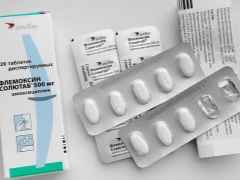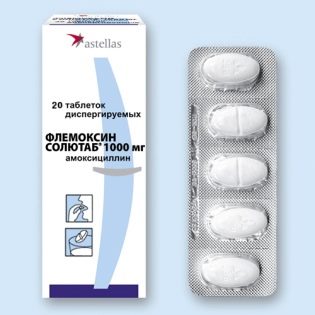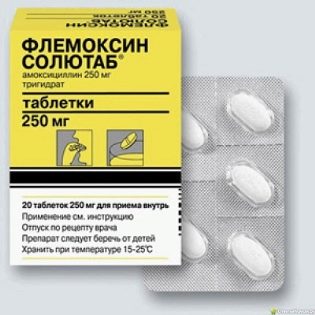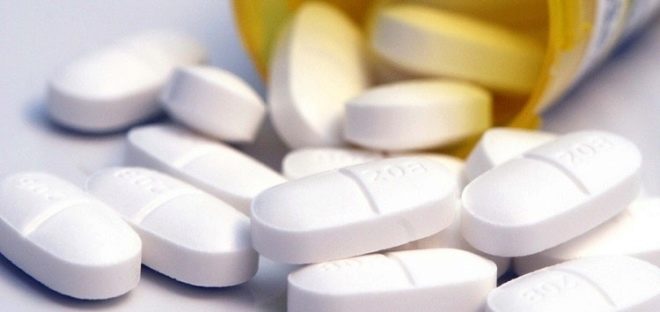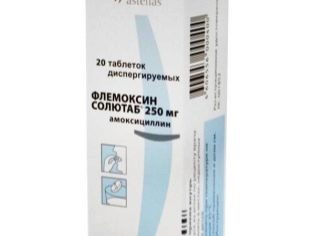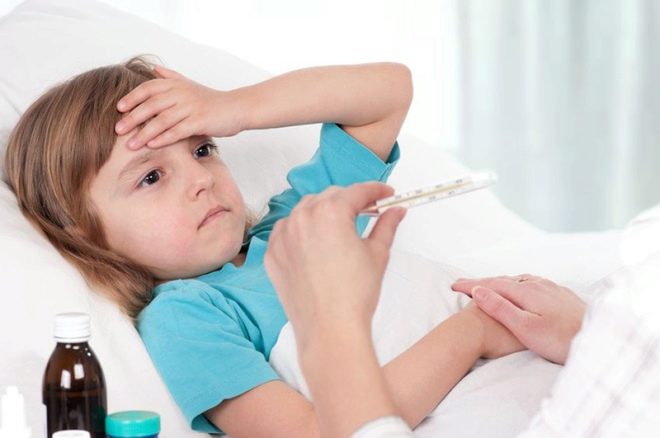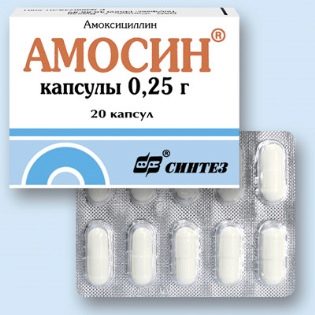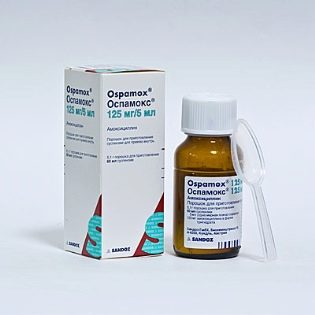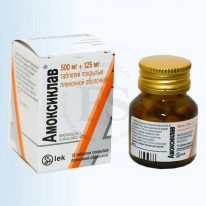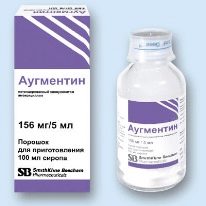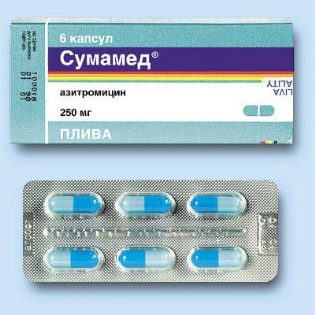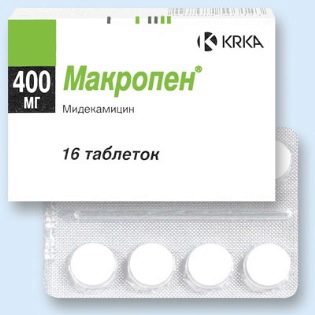Flemoxine Solutab for children: instructions for use
Penicillin antibiotics have been used in the treatment of infections for more than a decade, but they have not lost their relevance due to their extensive range of effects on various pathogens and effectiveness in the most common infections. One such remedy is Flemoxine Soluteb. It differs from analogs with the same active component in a particular dosage form, which is convenient to use in childhood.
Is it allowed to give it to the smallest patients, for example, a one-month-old baby or one-year-old toddler? How to take such pills and what dosages are used in children? Can this antibiotic harm the body of children and what negative symptoms does an overdose cause? What drugs can replace Flemoxin Solutab if this drug caused an allergy or was ineffective?
Release form and what is included
The drug is produced in the Netherlands in the form of tablets that can easily dissolve in water, so they are called dispersible and the word "soljutab" is present on the packaging of the medication. The main ingredient of these tablets is amoxicillin. It is contained in the medication in the form of amoxicillin trihydrate salt. Depending on the amount of such a compound, Flemoxin Soljutab tablets are distinguished, containing 125 mg and 250 mg each, as well as 500 mg or 1000 mg amoxicillin.
All of these drug options are oval white or light yellow pills that have a risk (according to it, the drug can be further divided into halves, which is important in the treatment of very young children). The difference between them is the digital designation on the tablet:
- 125 mg drug is marked with the number "231";
- on tablets of 250 mg you can see the inscription "232";
- 500 mg medicine is labeled "234";
- on the medication with the highest dosage there are the figures "236".
Tablets are sold in blisters of 5 pieces, and one box holds 20 tablets. Only the preparation containing 125 mg in one tablet is additionally represented by packs of 10, 14 and 28 tablets. They are packaged in 5 pieces or in blisters of 7 tablets.
Auxiliary components in the medicine with any dosage are the same. In order for the medication to be dense, but at the same time it was easily dissolved after contact with a liquid, microcrystalline cellulose and dispersible cellulose, as well as crospovidone and magnesium stearate are added to its composition. Saccharin is present for the sweet taste of the tablet and the solution prepared from it in Flemoxin Solutub. The smell of the drug is provided by vanillin, as well as flavors of mandarin and lemon.
Operating principle
"Flemoxin Solutab" is a representative of semi-synthetic penicillin antibacterial agents, which by their structure belong to a large group of beta-lactam drugs (in addition to penicillins, it also includes carbapenems, cephalosporin antibiotics and monobactams). Such drugs have a bactericidal effect on many species of bacteria, since they are capable of disrupting the synthesis of important components of cell walls, called peptidoglycans.. Influencing bacteria during their division and growth, "Flemoxin" causes their lysis (death).
The drug is active against various microorganisms, among which are:
- pyogenic streptococcus;
- Pneumococcus;
- meningococcus;
- tetanus bacillus;
- gonococcus;
- anthrax bacillus;
- Staphylococcus aureus;
- listeria;
- Helicobacter.
The drug may not work on enterococcus, Proteus, Salmonella, E. coli, Vibrio cholerae or Shigella, so when such a pathogen is detected, it is important to first determine the sensitivity and then start treatment.
There are also types of bacteria that Flemoxin does not affect at all, for example, pseudomonads or enterobacteria. In addition, this medicine is ineffective against viruses, so it is not used for SARS and other viral infections.
A swallowed tablet or a therapeutic solution made from it is absorbed rather quickly and does not break down in the stomach (the drug is resistant to acids). The maximum amount of amoxicillin is found in the blood about two hours after administration. The diet does not affect the absorption of the drug, so you can drink Flemoxin Solutab at any time of the day without taking meals. Removal of the drug from the body occurs in the urine, so kidney disease can affect this process.
Indications
Soluble tablets are used in infectious diseases that have caused bacteria susceptible to the action of amoxicillin. "Flemoksin Solutab" in demand in the treatment of:
- sinusitis, otitis, pharyngitis, tonsillitis, pneumonia, laryngitis and other bacterial diseases of the respiratory organs;
- myositis, bursitis, erysipelas, and other infections of soft tissue or skin;
- salmonellosis, dysentery, leptospirosis and other gastrointestinal infections;
- scarlet fever, endocarditis, peritonitis, and other diseases triggered by streptococci;
- cystitis, urethritis and other bacterial lesions of the urinary organs.
At what age is it allowed to take?
The drug is used in the treatment of children of any age, so it is prescribed for both children up to one year old, and for preschool children, and older children. The drug is more often prescribed to patients younger than 5 years old, since it is very convenient to give soluble tablets to such children.
In this case, the use of medication in both infants and schoolchildren or adolescents should be controlled by a doctor. Only after examining a specialist can one be convinced that such an antibiotic is needed, and also to accurately calculate the dosage required for a particular disease.
Contraindications
"Flemoksin Solutab" is not prescribed to children who have shown hypersensitivity to this drug or other drugs amoxicillin. This medicine is also contraindicated in allergic reactions to any beta-lactam antibiotic. Patients who are allergic to any other drugs, have been diagnosed with infectious mononucleosis, or have been diagnosed with renal failure, require caution in the use of tablets.
Medical supervision is also needed when prescribing "Flemoxin" to children with lymphocytic leukemia or any diseases of the gastrointestinal tract.
Side effects
Treatment with Flemoxin Solutab can adversely affect the patient's digestive system, resulting in nausea, tongue inflammation, dysbiosis, loose stools, changes in taste, vomiting, or stomatitis. In some children, the drug provokes colitis or liver damage. In rare cases, tablets cause inflammation of the kidney tissue.
The nervous system of the child may respond to taking Flemoxin with confusion, insomnia, behavior changes, headaches, anxiety, and other symptoms.The use of tablets can also worsen the process of blood formation; therefore, in a blood test of some children a decrease in the number of neutrophils, platelets and other cells is detected. In addition, the drug can cause allergic reactions (for example, rhinitis, redness of the skin or urticaria).
If a child's immunity is reduced, Flemoxin can cause candidiasis. In infants, this side effect is often manifested by a thrush in the mouth: the mucous of the mouth reddens and itches, and when viewed from the mouth of the baby, the mother may notice a white patina. In girls, the medication can provoke vaginitis, the symptoms of which are white discharge, itching of the vagina, pain when urinating, red color of the mucous membrane.
If you take "Flemoxin Solutub" incorrectly, superinfection develops, caused by the resistance of bacteria to the drug. Such a complication appears:
- if the sensitivity of bacteria to the drug is not taken into account;
- if the mother bought and gives the child an antibiotic when it is not required;
- if parents want to avoid harmful effects and independently reduce the dosage of "Flemoxin" at one dose or per day;
- if you accidentally missed one or more receptions;
- if the child was not treated, they discontinued the course of therapy after improving his condition.
Instructions for use
The tablet can be swallowed and chewed, and also divided into halves and drink water. However, in childhood, the most popular method of administration is the preparation of a syrup (the tablet is ground into powder and dissolved in 20 ml of water) or suspension (the crushed tablet is mixed with 100 ml of water). Such liquid medication options have a pleasant fruity taste, so it is easier for children to swallow them.
The dosage of "Flemoksina Solutab" should be chosen individually, because the age of the child, the severity of the infection, and the weight of the karapuz affect the calculation of the required dose. Per day, small patients can receive from 30 to 60 mg of amoxicillin per kilogram of their weight. If the disease is mild or the severity is defined as moderate, the drug is often used according to this scheme:
- child 1-3 years old write out tablets of 125 mg and give them three times a day (this can be either a whole tablet of 125 mg or half of a tablet of 250 mg, sometimes patients of this age should be given twice the dose of 250 mg);
- if the child’s age is from 3 to 10 years he is usually prescribed 250 mg tablets, the medication in such a single dose should be three times, but in some cases the doctor prescribes twice-daily intake of 375 mg, that is, 1.5 tablets of 250 mg (you can also dissolve two tablets with different dosages - 250 mg and 125 mg);
- if the patient is already 10 years old, He should take Flemoxine Soluteb either three times a day, at 375-500 mg, or twice a day, at 500-750 mg.
In severe cases, the drug is taken three times in a higher dose, which is determined by the doctor. The same tactic is used in case of a remote focus of infection (for example, if the middle ear has inflamed) or chronic infections with relapses. But in case of impaired renal function, the dosage is reduced taking into account the indicators of blood and urine.
The duration of the course of treatment with Flemoxine is usually 5-7 days. Only in case of detection of pyogenic streptococcus antibiotic should be given at least 10 days.
For other infections, the medication is taken while the symptoms of the disease are present, plus another 48 hours.
Overdose
Too high a dose of medication provokes vomiting, loose stools or severe nausea, which in severe cases or at an early age can lead to dehydration. If an overdose is detected, it is recommended to wash the baby’s stomach and give activated charcoal. In addition, in case of poisoning with “Flemoxin”, it is important to replenish the lost minerals and liquid, for which we use pharmaceutical preparations or homemade drinks for rehydration.
In severe cases, hemodialysis is prescribed to speed up the removal of excess amoxicillin from the child’s body.
Interaction with other drugs
If you assign "Flemoksin Solutab" with other bactericidal drugs, then their action will be mutually enhanced (this is taken into account in severe infection), and the use of bacteriostatic antibiotics, on the contrary, can weaken the therapeutic effect. Tablets should not be used with aminoglycosides, antacids, anticoagulants, diuretics, anti-inflammatory and many other drugs.
All drugs, when used together with "Flemoxin" can provoke side effects or its effect will change, are indicated in the annotation.
Terms of sale
The purchase of Flemoxin Solutab for a child is carried out according to a prescription from a doctor, therefore the doctor must first examine the patient. The price of the drug is affected by the dosage of amoxicillin in the tablet and the number of tablets in the pack. For example, a pack of "Flemoxin" of 20 tablets of 125 mg costs about 220 rubles, and for a pack of 20 tablets of 250 mg you need to pay 250-270 rubles.
Storage conditions
The shelf life of Flemoxin Soluteb is quite long and is 5 years from the date of manufacture. To prevent the drug from spoiling and not losing its medicinal properties, it should be stored at a temperature not higher than 25 degrees Celsius in a dry place.
At the same time, it is important that the medicine is not easily accessible to children, since the sweet taste of tablets may interest a small child, which will increase the risk of overdose.
Reviews
"Flemoksin Solutab" is in high demand among parents of young children, since it is convenient to give this form of amoxicillin to patients of any age. The drug is easily diluted with water, and the taste of the finished solution is pleasant. Judging by the reviews, the drug effectively copes with various infectious diseases (for example, otitis, sore throat or bronchitis), helping to eliminate high fever, cough, earache and other symptoms. Because of the sweet taste, most children drink a pill without any difficulty.
Nevertheless, there are also negative opinions, because "Flemoxin" does not help some patients, which is often due to the resistance of bacteria to its main component. You can also see complaints about side effects while taking pills.
Although they are rarely noted, sometimes babies develop nausea, rash, or other negative reaction. As for the price of the medicine, some mothers consider it overpriced and buy analogues cheaper, while others call it acceptable.
Analogs
If it is necessary to replace "Flemoxin Solutab" with a similar antibiotic with the same active ingredient, The doctor may prescribe a variety of other drugs.
- «Amoxicillin». Such a domestic drug is produced in granules (of which they make a suspension approved from birth), tablets and capsules (solid forms are used from 5 years of age). The average price of one bottle of granules is 90 rubles.
- «Amosin». This medicine of the Russian manufacturer is represented by capsules, suspension (it is made from powder) and tablet form. For 10 tablets of 250 mg you need to pay about 30 rubles.
- «Ospamox». Such a drug is produced in Austria in various forms, among which there are tablets, granules, capsules, and powder. The smallest patients are prescribed in the form of a suspension, which is made from granules or powder. Such forms are used at any age. On average, one bottle of pellets "Ospamox" costs 80 rubles.
- "Hikontsil". This variant of amoxicillin from Slovenia is represented by capsules of 250 and 500 mg, as well as powder. The cost of 16 capsules 0.5 g is about 130 rubles.
- "Amoxicillin Sandoz". This Austrian antibiotic is used in the treatment of children over 3 years old, because it is made only in tablets of 500 and 1000 mg, coated.On average, for a package of 12 tablets of 0.5 g, you need to pay 125 rubles.
- "Ecobol". This drug based on amoxicillin is also available only in pill form. The approximate price of 20 tablets of 250 mg is 60 rubles.
It is also possible to replace "Flemoxin" as another drug from the penicillin group ("Ampicillin"," Oxacillin ","Oxamp"), And on one of the cephalosporin antibiotics ("Suprax», «Zinnat»).
A combination of amoxicillin and clavulanic acid is considered quite effective. It contains drugs "Amoxiclav"," Panklav ","Flemoklav Solyutab"," Augmentin "and others. The addition of a second active ingredient to these drugs, which is clavulanic acid, helps prevent the destruction of amoxicillin in the patient's body under the influence of enzymes called penicillinases.
There are drugs with antibacterial action that can be used for allergies to amoxicillin and other penicillin antibiotics.
- «Sumamed». This drug azithromycin is prescribed from 6 months of age and is in demand for sore throat, chlamydia, pneumonia, otitis, and other diseases. It is manufactured in several forms - suspension, dispersible tablets, lyophilisate for injections, capsules and tablets in the shell.
- «Macropene». The basis of this antibiotic is midekamitsin, able to cope with whooping cough, diphtheria, enteritis, mycoplasmosis and other infections. It can be used as a suspension even in the smallest patients (from birth), and in tablet form, from the age of 3 (if the child weighs more than 30 kg).
- «Vilprafen Solutab». Like Flemoxin, this drug is made in the form of soluble tablets (it is produced by the same manufacturer). Its action is ensured by josamycin, which shows its effectiveness in phlegmon, scarlet fever, tooth flux, purulent otitis, blepharitis and other bacterial infections.
The medication may be administered to infants with a weight of more than 10 kg.
In the next video, Dr. Komarovsky will remind you about how antibiotics were discovered, why you are needed and when you really cannot do without them.
